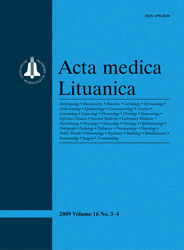 ISSN 1392-0138 ISSN 2029-4174 (online) |
2008 m. Nr. 3 Disorders of sexual development of school boys in clinical praxis: the study of Rīga Stradiņš University, 2005–2007
Background. Disorders of sexual differentiation and sexual development is the topic, which was little spoken of in society in recent past, and about which doctors had very superficial knowledge. The aim of our research is to study how sexual development is exposed in Latvia among school-age boys and whether any deviations in sexual development can be encountered. Material and methods. The chief indicator of secondary sexual signs is the development of testicles, which was chosen to be the basis for our study. 683 boys involved into the study, aged from 7 to 18 years, were divided into 12 age groups. Sagittal size or thickness of the testis was measured by J. Tanner’s method. By sagittal size or the testis thickness we understand the measurement, which is carried out from the external surface of the testis towards its internal surface. Results. In the study process we found out, that the problems of testicle development among Latvia’s boys are similar to those in the world described in the literature. The most surprising finding was that part of the boys studied and their parents did not have any idea of the existence of this problem. Therefore, the question arises concerning the quality of medical professionals’ duties and the attitude towards man’s health as such. Conclusions. The growth of the testes is gradual, reaching its maximum at puberty, the size of the right and left side testes do not differ. Developmental deviations of the testes in the populations of boys are rather wide-spread. The most common developmental deviation of the testes is bilateral cryptorchism. Keywords: sexual development, boys, anthropometry, cryptorchism |
Issues:
2011 - Vol.18 No. 1, No. 2, No. 3, No. 4 2010 - Vol.17 No. 1-2, No. 3-4 2009 - Vol.16 No. 1-2, No. 3-4 2008 - Vol.15 No. 1, No. 2, No. 3, No. 4 2007 - Vol.14 No. 1, No. 2, No. 3, No. 4 2006 - Vol.13 No. 1, No. 2, No. 3, No. 4 2005 - Vol.12 No. 1, No. 2, No. 3, No. 4 2004 - Vol.11 No. 1, No. 2, No. 3, No. 4 2003 - Vol.10 No. 1, No. 2, No. 3, No. 4 2002 - Vol.9 No. 1, No. 2, No. 3, No. 4 2001 - Vol.8 No. 1, No. 2, No. 3, No. 4 |